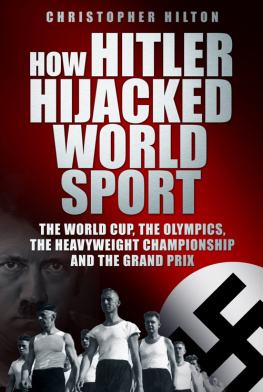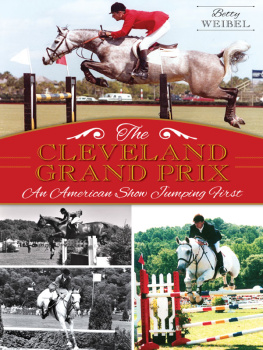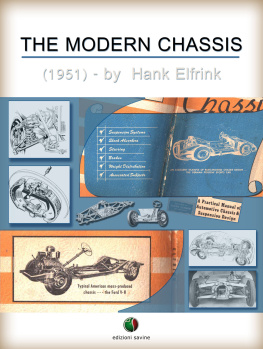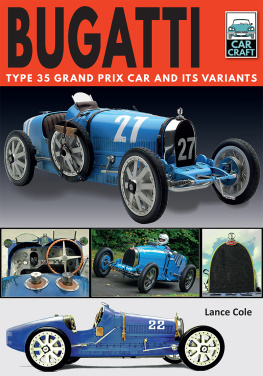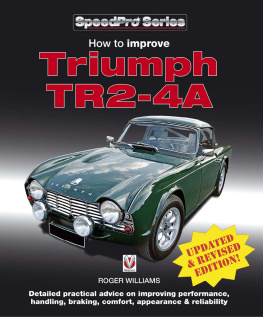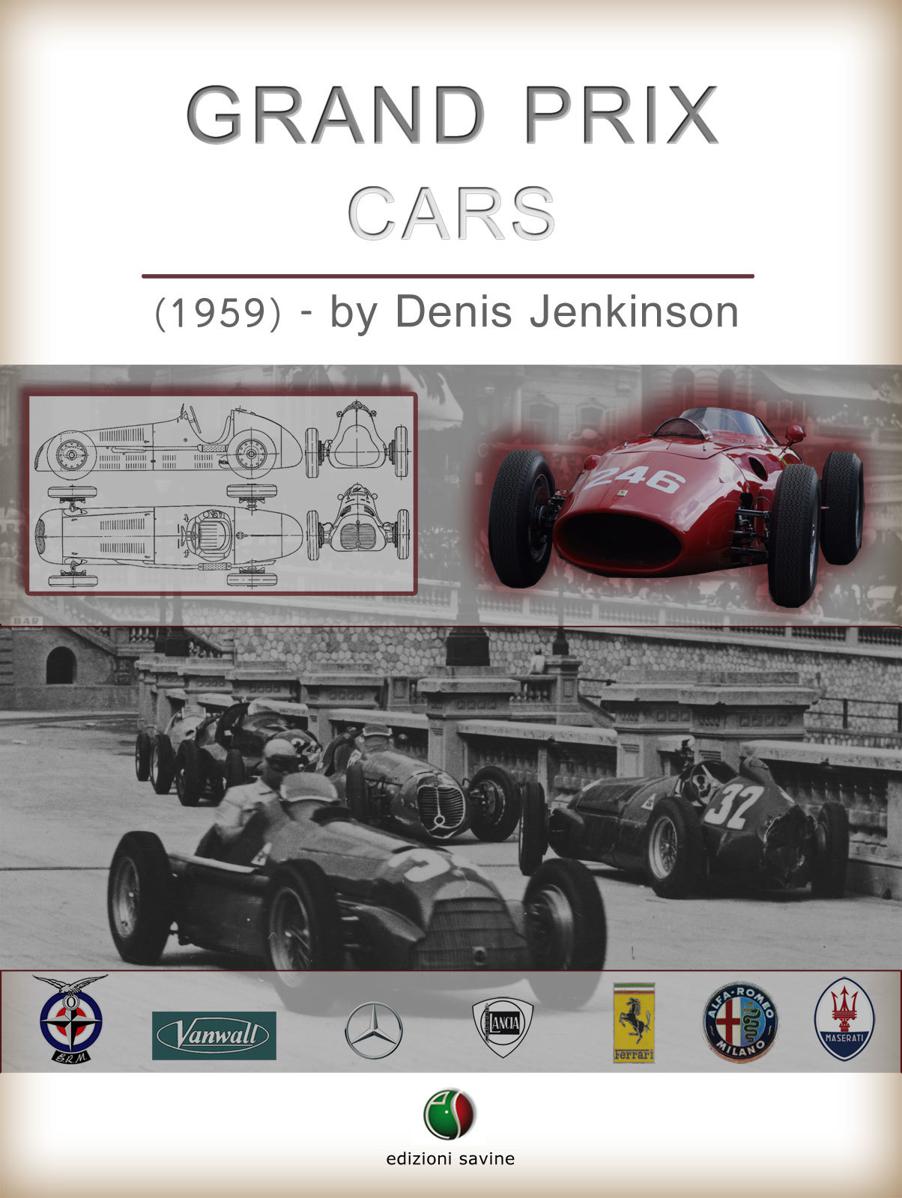Grand Prix Cars
by Denis Jenkinson
New digital edition of:
Grand Prix Cars
by Denis Jenkinson
1959 by Sport Car Press
Copyright 2015 - Edizioni Savine
All Rights Reserved
Strada provinciale 1 del Tronto
64010 Ancarano (TE) Italy
email: info@edizionisavine.it
web: www.edizionisavine.com
ISBN 978-88-96365-67-0
CONTENTS
FOREWORD
In compiling this brief history of Grand Prix racing, along with descriptions of the more successful cars, I have limited myself to the period since World War II as the present day Grand Prix cars are mostly derived from the development and design of the early post war years. Although many ideas were taking shape in the period of the mid-thirtiessuch as the use of de Dion rear axle layouts, independent front suspension systems and hydraulic brakesthe main interest lay in engine design under a free ruling on capacity.
It was not until about 1950 that a renaissance began in chassis design for Grand Prix cars and from then on a great deal of knowledge was gained; enough in fact, to enable roadholding to become a very exact science rather than a hit-and-miss affair. This development in the chassis and the search for improved road holding and higher cornering power was accentuated by the beginning of the era of unsupercharged racing, when power outputs were severely curtailed and speed had to be found by other means.
Although the German cars of the 1934-39 period showed enormous technical advances, especially as regards engine design and supercharging knowledge, and provided some truly homeric racing, they look very crude and unimaginative beside the Grand Prix cars of today. In 1939 when European racing ceased for the war, the supercharged 1 1/2 -litre car, as exemplified by the quite small Alfa Romeo, was just beginning to show its possibilities on a fast but twisty circuit in comparison with the big Grand Prix cars of that time, as witness the Swiss Grand Prix of 1939, or the comparison of the 1938 and 1939 Tripoli Grand Prix events.
Had the war years not intervened, the trend towards smaller and more manageable Grand Prix cars would have followed, so that when this happened during the postwar period it was nothing more than natural evolution. For these reasons, the period of Grand Prix racing from 1946-58 can be looked at as a single phase in the development of the Grand Prix car, and for that reason I have dwelt mainly on that period.
Denis Jenkinson,
Hampshire, England.
BIRTH OF THE GRAND PRIX
Before we look too closely into the whys and wherefores of Grand Prix cars, and make a study of the various types and makes, let us first discuss the words Grand Prix. Of French origin, they mean literally, Great Prize, and the equivalent in Italian is Gran Premio, in German Grosser Preis, in Dutch Grotj Prij, and so on in almost any language. It is only in English (and American) that the equivalent two words of that language are not used; we have traditionally preferred the French words, Grand Prix.
This is probably due to the close connections socially and geographically between England and France, and America has followed Englands lead. In continental circles the term Grand Prix is used for many things apart from motor car racing, and the name Grand Prix dhonneur, or Honorable Great Prize can be, and is, applied to such varied things as cake making, dress design, and wine making. So it is easy to see that the original use of the term Grand Prix in connection with automobile racing was applied to the best performance, and subsequently to the best race, and the name Grand Prix Car was given to any car competing for the Great Prize.
Although the first motor competition was held in 1894 and the first motor race in 1895, it was not until 1906 that the title of Grand Prix was given to an event. Between these dates many motor races took place and the principal events were undoubtedly those for the Gordon Bennett Cup, an award put up by a great sportsman of the early 1900s and competed for annually. In the early days of racing the classification of the competing cars was pretty much free-for-all, but from 1902and specifically for the Gordon Bennett racethe competing cars had to comply with a formula decided upon by an International body of representatives from those countries interested in motor racing. This body was based in Paris, the capital city of the first country to hold a motor race.
By 1906 the Gordon Bennett race was losing favor and the principal race of the year was named the Grand Prix, this being the first time that the term was applied to motor racing, and the cars competing in this event had to comply with a rule which stipulated a maximum weight of 1000 kilogrammes, or 2200 lbs. From that date onwards the International Formula for racing cars and the name Grand Prix have been synonymous. But already a complication was beginning, for countries other than France were organizing motor races, and both Germany and Italy held an important race in 1907 which they considered to be of equal importance to the Grand Prix.
As if to confuse the issue even more, the German race, the Kaiserpreis, and the Italian race, the Targa Florio, were both run according to their own special regulations, so that any manufacturer who wanted to compete in all three events was forced to build three different cars. With France being the instigator and still the leader of motor racing, the 1907 Grand Prix Formula can be considered the important one, and it merely limited fuel consumption to 9.4 miles per gallon. The following year, 1908, the French decreed that their Grand Prix should be run according to a limit of piston area, this being a maximum of 117 sq. ins., leaving the number of cylinders, and bore and stroke choice entirely open.
The cost of building these special cars for the major race of the year was by now becoming rather exhorbitant, and after the 1908 Grand Prix the manufacturers got together and decided to abstain from any further Grand Prix racing. In consequence of this no Grand Prix was held in the following two years, and in 1911 a very mediocre and poorly supported Grand Prix was held.
In the meantime racing had continued for smaller cars, for while the Grand Prix proper was in being there were always other races for a class of car known as voiture legere or voiturettewhich is to say, light cars. The cars built to the Grand Prix formulae were inevitably and by definition the biggest and best, though not always the fastest, even though they were intended to be, and the voiturette class was only considered as a subsidiary to the Great Prize category.
When the manufacturers forced the abandonment of the Grand Prix in 1909, the light cars continued to race and their regulations and limitations formulated racing and design for many years, even though the Grand Prix was revived in 1912. For this year the formula was thrown wide open with no restrictions, the French title being Formula Libre, and this was done in the hope of attracting the maximum number of entries. This it did, and whereas Fiat and Lorraine entered monster cars of 15 litres, whose design dated back to the last Grand Prix of 1908, Peugeot entered comparatively small cars of only 7.6 litres engine capacitytheir design stemming directly from the previous two years of voiturette racing.
In this free-for-all of 1913 the little Peugeots were victorious, and this made designers realize that mere engine capacity was not necessarily all it took to win races. For 1913 the French went back to fuel consumption formula, this time of 14 m.p.g., their apparent desire all the time being to limit the performance of the Grand Prix racing cars, as every year they felt that cars were becoming too fast. In fact, the cry from the French Automobile Club of too fast has come from Paris since the very beginning of motor racing, and persists even today.




